
Stage 15 of this year’s Tour de France has been one for the history books as far as climbing performances are concerned. The final Hors Category climb of the stage up to the finish at Plateau de Beille saw Tadej Pogačar drop Jonas Vingegaard, win alone and so tighten his grip on the yellow jersey.
This performance was so good that it has been described by some as the greatest climbing performance in Tour de France history. Pogačar set a new record time on Plateau de Beille - beating the previous record held by Marco Pantani by three minutes and thirty seconds.
The climb has featured in the Tour six times since 1998 before this year’s edition with the most recent ascent taking place back in 2015 when the stage was won by Joaquim Rodríguez.
Pantani’s time of 43:28 had stood the test of time, with the likes of Lance Armstrong and Alberto Contador unable to come close to beating it. On Sunday, Pogačar, Jonas Vingegaard and Remco Evenepoel were all faster.
With multiple riders breaking the 26-year-old record, the question of 'how?' does seem like a justified one.
While great climbing is about the power to weight ratio, the full picture of climbing performance is a far more intricate cocktail of elements. Since Pantani’s ascent in 1998 bikes, equipment and clothing have all made leaps forward.
The question is: how much of Pogačar’s record-breaking accent can be attributed to technological developments? We tried to answer the question.
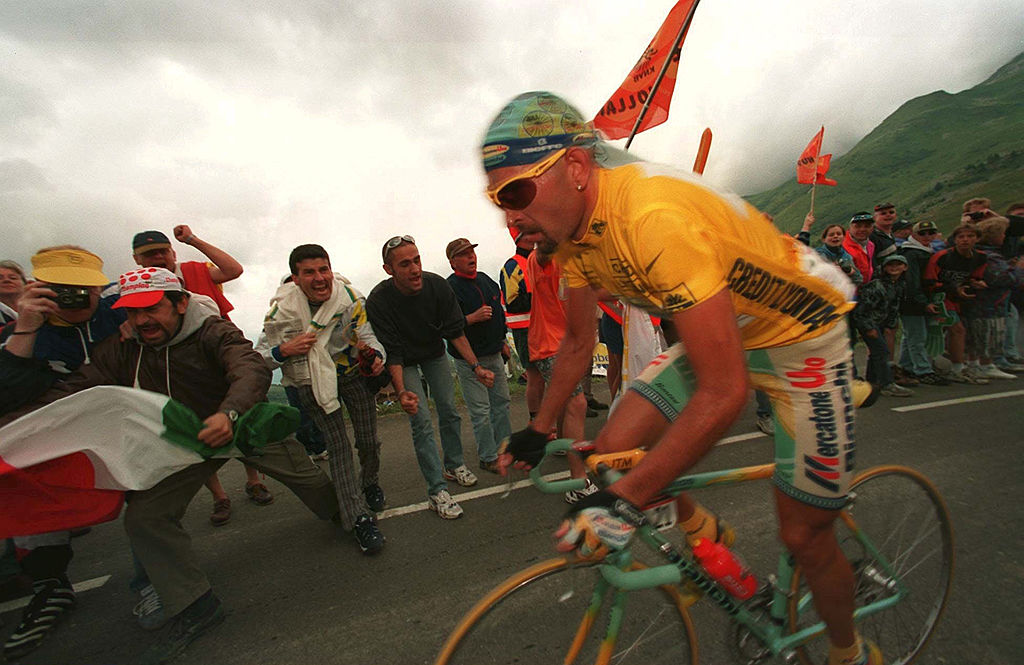
Aero could be almost everything
It is easy to dismiss aerodynamics on an 8% average 15-kilometre climb. Yet Pogačar averaged 23.5km/h for the entirety of the climb up Plateau de Beille.
Once he was solo and distanced Vingegaard with five kilometres to go, he upped the pace averaging 26.2km/h. At these speeds, aerodynamics still make up a large percentage of the resistive force facing the rider.
Aerodynamics are hugely complicated and we could spend thousands of words and dozens of graphs estimating the gain of only one aero component at this speed on this incline in these weather conditions.
For the purposes of this feature, this is very much an estimate based on the broadly accepted gains of numerous components established through aerodynamic testing (we've done some of that ourselves - check out our wind tunnel helmet test).
Firstly the riding styles between Pantani and Pogačar are very different with Pogačar spending the majority of the climb seated, whereas Pantani preferred to climb out of the saddle on the drops. From a simple CdA perspective, Pantani would have needed to push more watts than Pogačar to compensate for his less aerodynamic riding position.
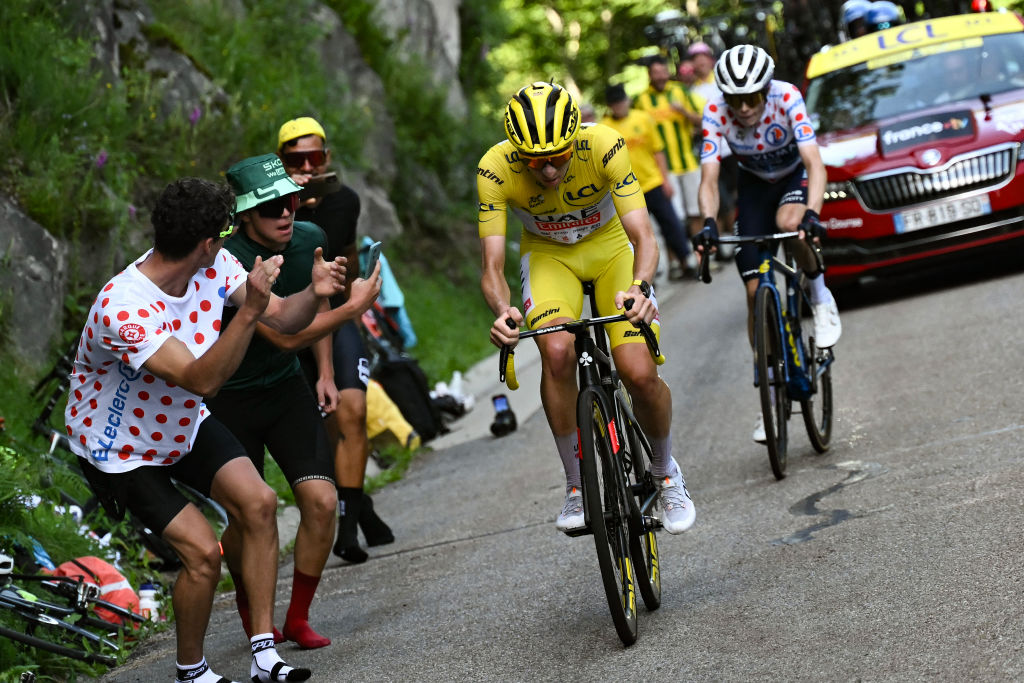
Pogačar, Vingegaard and Evenepoel were wearing aerodynamically optimised skinsuits that use high-tech fabrics and bespoke tailoring to ensure that the garment is as slippery as possible through the wind. Pogačar and everyone in the modern peloton would have had a measurable advantage on Pantani who wore a traditional jersey and bib shorts ensemble.
The rider is the biggest aerodynamic obstacle, so making sure they have as low drag as possible is the most sizeable aerodynamic gain modern cycling has made.
In some testing carried out by mywindsock.com they found that on the flat at 40km/h a skinsuit can save upwards of 20 watts compared to a typical jersey and bib configuration. At the slightly slower speed that Pogačar rode the climb, he would not experience this level of benefit but comparing that effective CdA increase at lower speed, it would be a fair estimate to suggest Pogačar gained around 5 watts over Pantani’s clothing.
Pantani was also riding box section aluminium rims from Campagnolo with 21mm tubular tyres glued to them. Although these were light they were offered very little in the way of aerodynamics. By comparison, Pogačar was rolling on a set of Enve SES 4.5 carbon clincher wheels set up tubeless. These wheels sport a depth of 40mm at the front and 50mm at the rear with the wide rim profile optimised for his wide 30mm tyres.
It is hard to put an exact estimate on the benefit that using deeper section rims would have but at 23.5km/h it is certainly advantage Pogačar on this one.
It is fair to assume that the difference between the box section rims and the deep section carbon rims is worth a handful of watts even at the lower speeds associated with climbing.
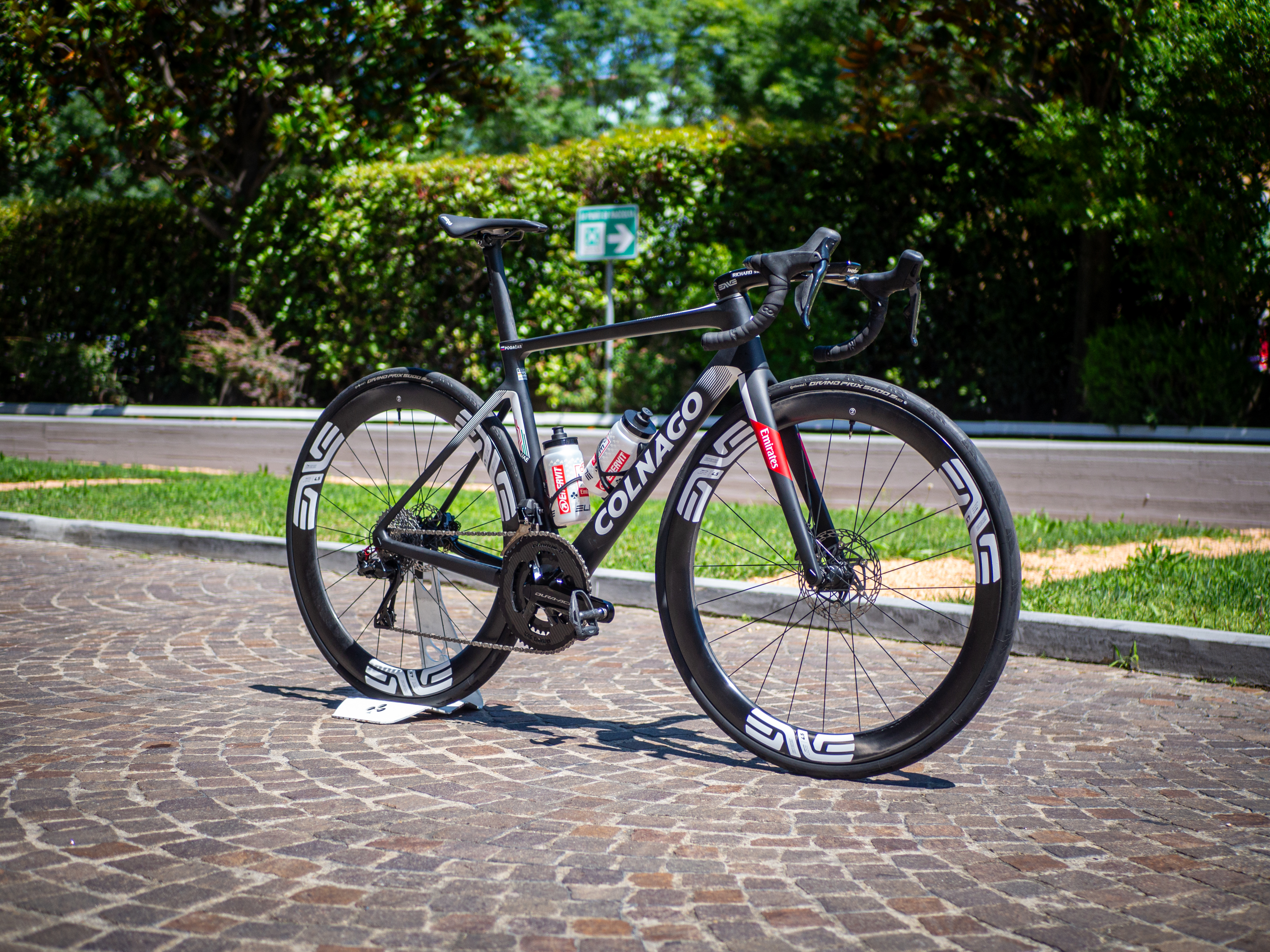
Finally on the aerodynamic front is the frame itself. The V4RS used by Pogačar might not be an all-out aero bike but in comparison to Pantani’s Bianchi it can be considered one.
The fully integrated cables, aero profile cockpit and bladed profiles all allow the bike to cut through the wind. On the flat the aero bars alone are likely to save somewhere around 10 watts however, at the speed Pogačar was climbing these benefits would be less pronounced. The frameset in total is likely to have saved somewhere between five to 10 watts.
Total aerodynamic advantages estimate for Pogačar: 15-20 watts (excluding the difference in riding position)
Drivetrain efficiency
This is an area that still has room for improvement, especially for Pogačar who was seen to be cross-chaining at times on the climb sitting in the big chainring and the largest sprocket on the cassette. Although an optimised chain line could offer savings of around five watts, Pogačar has a notable advantage over Pantani when it comes to drivetrain efficiency as a result of lubrication.
Modern-day chain lubrication is significantly better at decreasing frictional losses than the lubricants used in Pantani’s era. Wax treatments cover the chain in a paraffin-based wax that coats both the internal and external surfaces of the chain. Along with the paraffin are additives such as molybdenum disulfide that microscopically smooth the surface of the chain allowing the links to articulate with less friction. A good wax treatment can offer a saving of between six to eight watts over even a premium oil-based lubricant.
Total drivetrain advantage for Pogacar: Conservatively 6-8 watts
Tyre width and rolling resistance
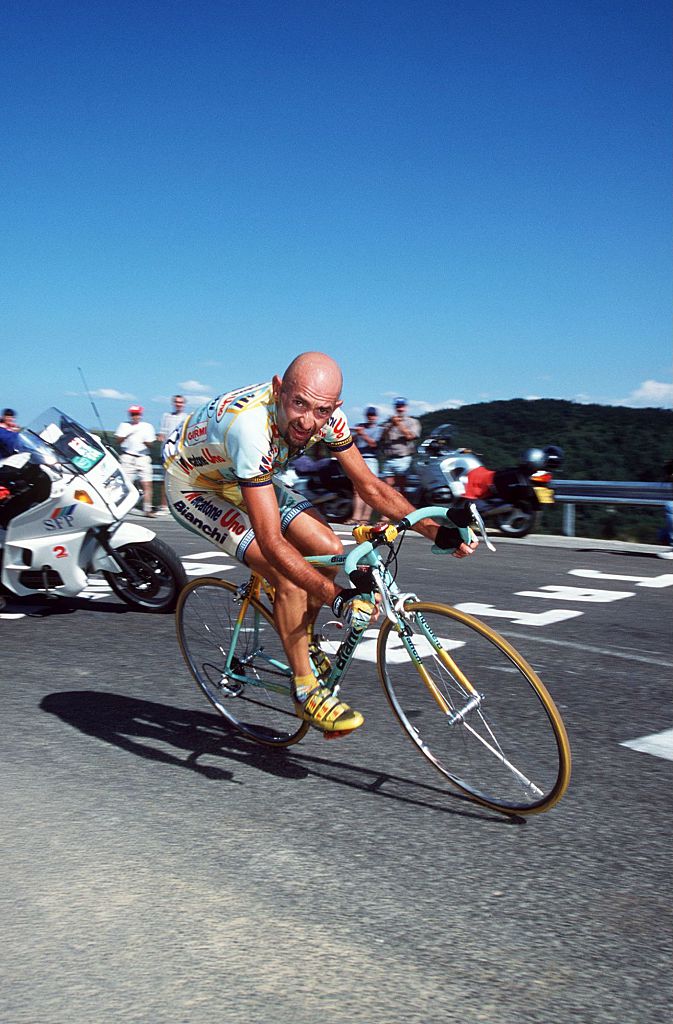
In 1998 Pantani’s Bianchi was fitted with 21mm Vittoria Corsa CX TT tyres mounted to Campagnolo’s Electron wheelset. At the time the school of thought was a narrower tyre was more efficient as it would have a smaller contact patch resulting in less rolling resistance.
In more recent times this theory has been proven time and time again to be outdated with riders frequently running tyres over 28mm in width. The reason that narrower tyres are less efficient than wider tyres has a lot to do with the surface they roll on.
Tarmac is far from smooth if you zoom in a little and look at the surface, even on seemingly ‘smooth’ roads the surface is full of imperfections that cause the tyre to deform. It is this deformation that causes energy losses through hysteresis.
The contact patch of a narrow tyre is thinner but longer than a wide tyre, as a result, more of the tyre has to deform to the surface of the road. In essence, wider tyres retain a more round profile than narrower tyres. The exact benefit is hard to accurately calculate without knowing the specific tyre pressures used by both riders.
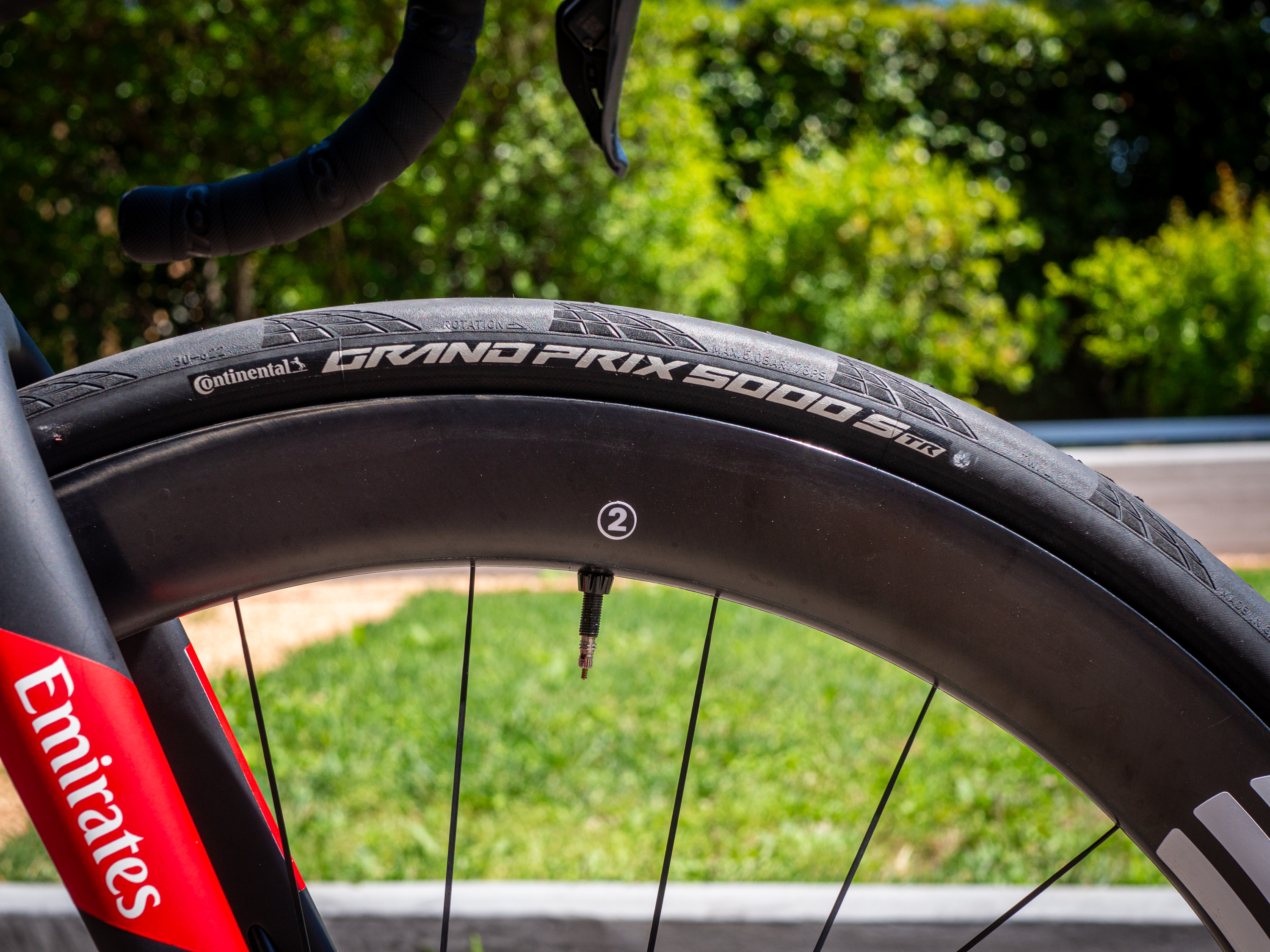
Bicyclerollingresistance.com have a wealth of data on how efficient different tyres are in different configurations. Although there is no data available for the specific tyre setup used by Pantani, the Continental GP5000s TR tubeless tyres used by Pogačar roll around five watts faster than Vittoria’s Open Corsa CX III from 2014 in a 23mm width. If we extrapolate this to the 21mm width used by Pantani then the difference expands to around seven watts.
Total rolling resistance advantage for Pogačar: Around 7 watts
Total benefit to Pogačar
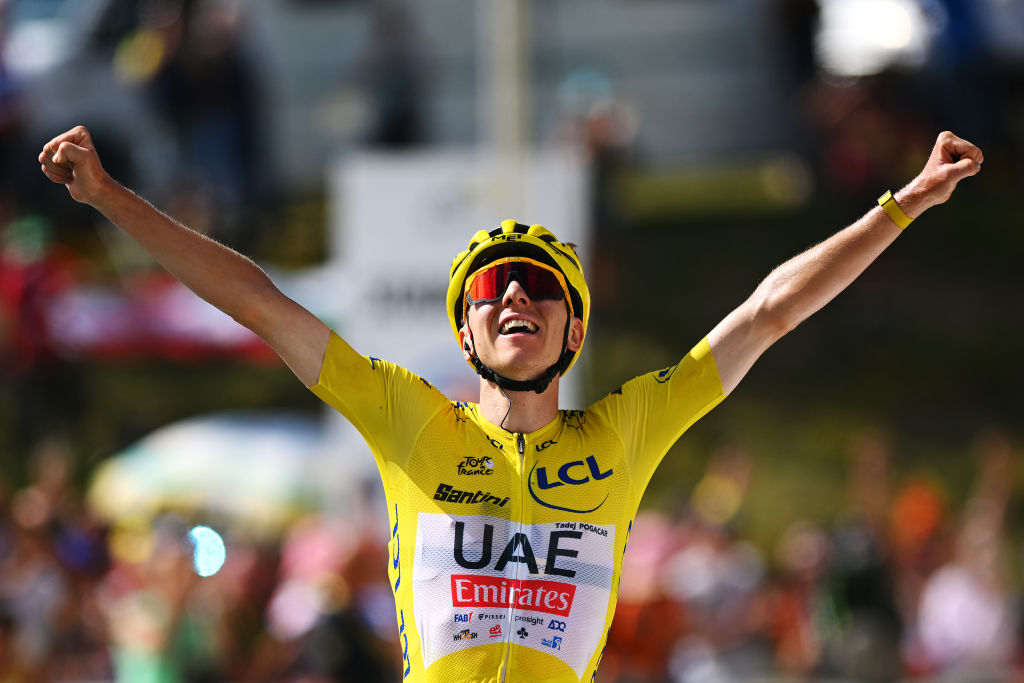
From these estimations, we could suggest that Pogačar had a technical advantage over Pantani of around 40 watts. So, physiological and tactical factors aside, these gains could go some way to explaining how riders can now beat climbing records from the slightly problematic protagonists of the 1990s.
Using mywindsock.com to calculate the effect a 40-watt disadvantage would have on Pogačar’s performance suggests that he would have completed the 15km climb 2:47 slower.
That makes his performance still record-breaking even on a technologically level playing field but the difference would have been a far slimmer 43 seconds.
The developments in bicycle equipment do nothing to diminish just how impressive Pogacar’s performance was on the climb.
After the stage, Pogačar himself said that the accent of Plateau de Beille was his best performance ever.
Better bike tech or not, Pogačar's ride last Sunday was one of the most dominant climbing performances in the history of the sport.
Get unlimited access to all of our coverage of the Tour de France - including breaking news and analysis reported by our journalists on the ground from every stage of the race as it happens and more. Find out more.







